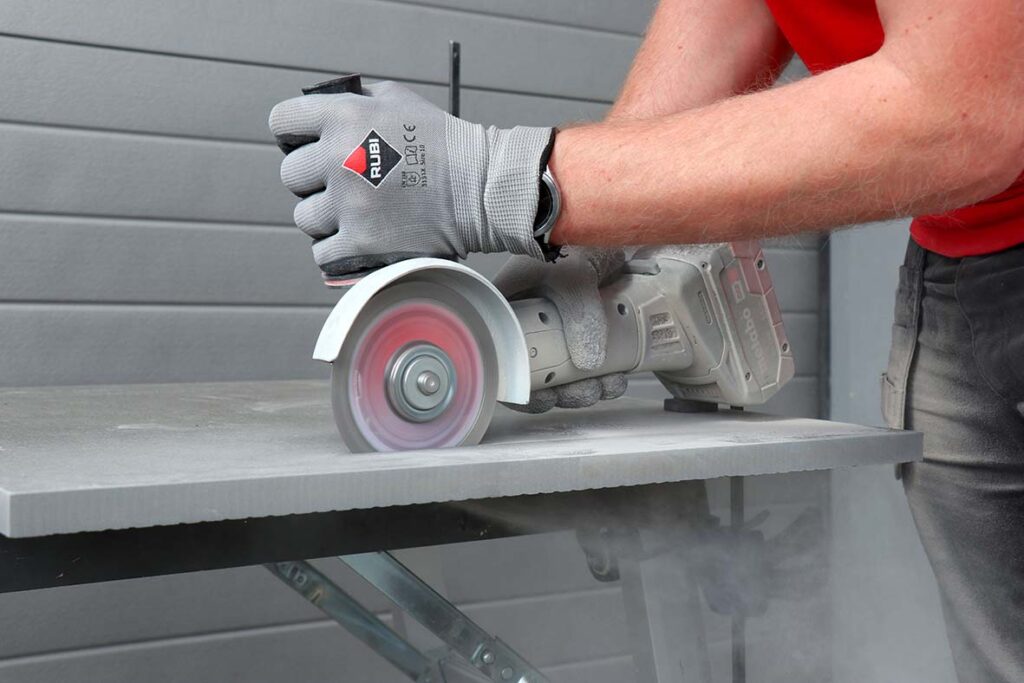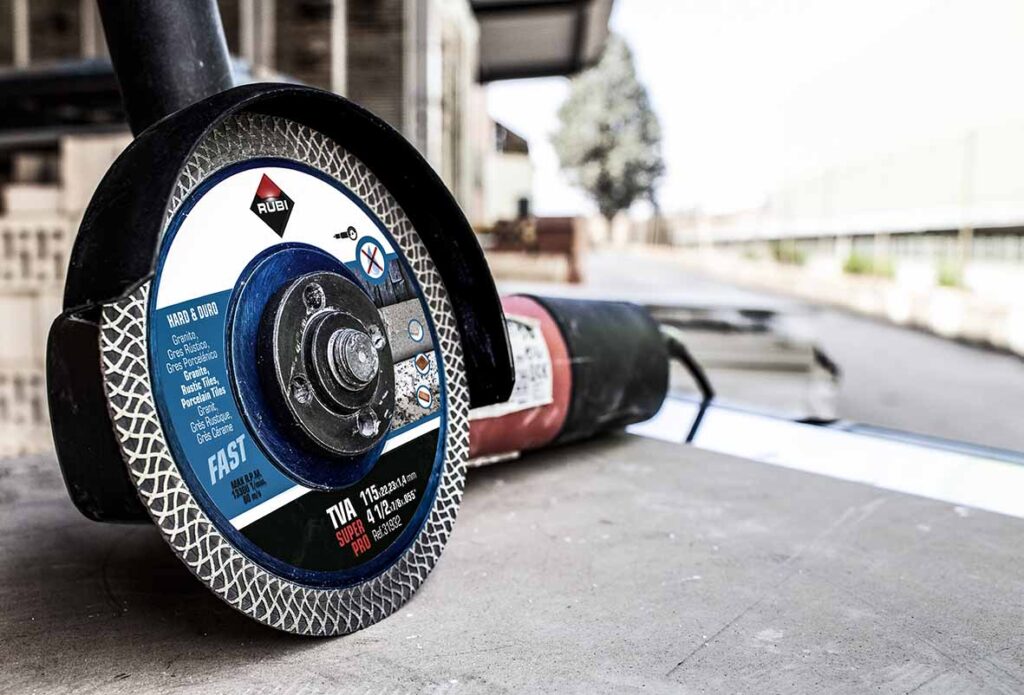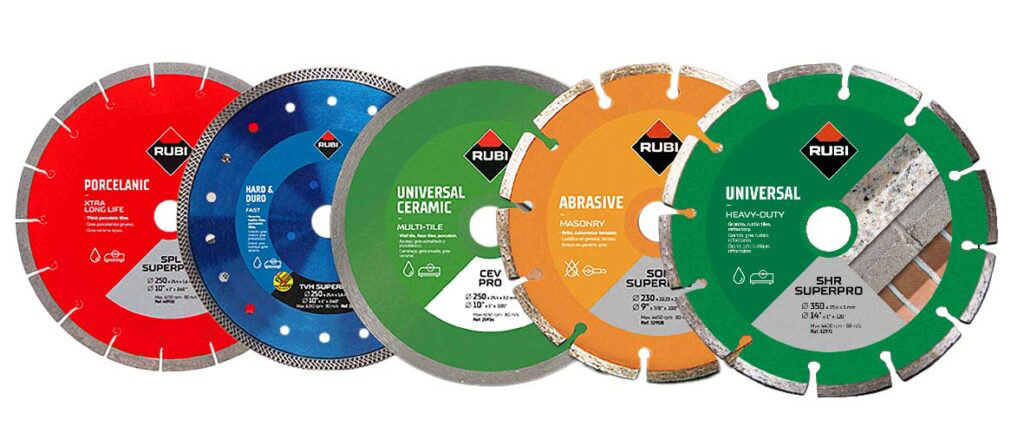There are different types of diamond blades for cutting various tile materials. But knowing how to cut each material is a key skill for a successful tiling career. Understanding how to tile, how blades work and how they are made will help us better understand what type of blade we need, or which is best for cutting each material.


What Are Diamond Blades?
Diamond blades are super-abrasive and consist of a circular body, mostly made of steel. The steel body of the blade is called the core. The diamonds are adhered to the core in the form of a continuous rim or in segments. This cutting material, called the diamond band, can be bonded to the core of the blade in different ways, but the most used by RUBI is laser welding.
Diamond Grains
The type of bonding of the diamond grains can be done in three different ways: sintering, electroplating, and vacuum brazing. But in the case of specific blades for cutting ceramics, we will usually be talking about sintering.
In the sintering process, the diamond particles are mixed with the metallic binder and merged by pressure and temperature. This creates a system with different layers of diamond that are exposed as the tool wears. This metal and diamond amalgamation is called the “bond.”
All About Diamond Blades
The relationship between the size of the diamond grain, the concentration of the grains or particles, and the hardness of the bond varies according to the requirements of each blade.
- If we cut hard materials, we use a small grain type, with a high concentration of diamond and a soft bond.
- If we cut abrasive materials, we use a large grain size, with low diamond concentration and a hard bond.
- If we cut all kinds of materials, we use a large grain size, a low diamond concentration, and a soft bond.
Ideally, both the bond and the diamond wear at the same time. If we have a soft bond, the metal will wear away, and the diamond will always be exposed to cut efficiently, but the blade’s life will be affected, especially when cutting abrasive materials.
On the contrary, if we have an overly hard bond, the diamond will wear away without being replenished because the binder does not wear away simultaneously, and the tool will lose its cutting effectiveness. This is when we say the blade is “dull.”
To solve this problem, we can use a cleaning block, which is also super-abrasive. The cleaning block will wear away the bond of the blade and make the diamond particles from the lower layers appear. It will also clear away any debris left on the blade after making a few cuts.
Sintered Diamond Blades, Types:
The We have a wide range of sintered diamond blades available from RUBI. Below is a list provided to show the differences between each type:
Continuos Rim
Provides the best finish. Used for cutting and mitering tiles with thicknesses <25 mm.
Turbo
A great combination. High performance and cutting speed with high-quality finishes.
Viper
The evolution of the TURBO blade with greater quality and speed. Ideal blade for high-hardness materials.
Segmented
The fastest. Maximum speed and better cooling of the blade. For cutting materials with thicknesses >25 mm.
Turbo Segmented
For cutting all types of materials with maximum speed.
J-Slot
Cutting-edge technology. High speed in the hardest materials. Specially designed for straight cutting of porcelain tiles. Eliminates the stresses generated during cutting.
The higher the cutting speed, the lower the quality and vice versa. The blades with the most balanced speed-quality ratio are the turbo and viper types.

How To Choose Diamond Blades
Now that we know how diamond blades work, how they are made, their types, and characteristics, we must consider three aspects when choosing a blade:
What Type Of Cut Are We Going To Make?
Depending on the type of cut we are going to make, we should think about what type of machine we will use. An electric machine? A grinder? And consequently, what type of cooling we will have?
We must consider that blades cut by friction and are super-abrasive tools. Therefore, this friction generates high temperatures during cutting, leading to two types of cutting: wet cutting and dry cutting.
In dry cutting, the only cooling is done by the ventilation generated by the blade itself as it rotates. Dry cutting blades can be cooled with water for greater durability and better finish, but wet cutting blades should always be used with water.
At RUBI, we have blades for cutting tiles in both dry and wet cutting. Therefore, before deciding, we must know what machine we will use and the type of cooling.
Types Of Materials We Need To Cut
The second thing we need to consider is what types of materials we will cut.
When we talk about cutting ceramics or ceramic materials, both fall into the group of siliceous materials. These materials, composed mainly of silica, have medium-high hardness, although some can also present very high abrasiveness particles.
Among the most common siliceous materials is the group that interests us: ceramics or ceramic materials such as tiles, glazed stoneware, or porcelain stoneware. Glass and granite also fall into this group.
Therefore, due to the hardness of these materials, we will need a combination of small grain, with a high concentration of diamond, and a soft bond that wears out simultaneously with the diamond to avoid dulling the blade and have good tool performance.
Cutting Speed Vs. Quality Of Finish
The third aspect to consider is whether we need cutting speed or quality of finishes.
This will depend on the types of cuts we are going to make. It is not the same to make a straight or diagonal cut, where we may need speed, as to make a miter cut where we need precision and quality of finish.
Not all blades are suitable for all types of cuts. For mitering or making a miter cut, we need blades with enough reinforcement and core thickness to withstand the 45º cut without breaking. The minimum core thickness for mitering varies depending on the blade’s diameter.
In summary, once we have considered whether we will do wet or dry cutting depending on the machine we will use, the hardness properties of a material like ceramics, and whether we need cutting speed or quality of finishes, we are ready to choose the best blade for cutting ceramics.

Rubi Diamond Blades Range
From the RUBI diamond blade range, we can highlight the following:
For Dry Cutting:
CPR – Continuous rim blade, recommended for fine cutting of porcelain stoneware with a thickness of less than 20 mm. Provides one of the best finishes. Available in diameters of 115 and 125 mm.
TCR – Turbo type blade, recommended for fine cutting of porcelain stoneware with high performance and cutting speed with high-quality finishes. Available in diameters of 115 – 125 – 180 – 230 mm.
CPJ – J-Slot type blade, increases cutting speed on very hard porcelain stoneware tiles while reducing the stresses generated during cutting. Available in diameters of 115 and 125 mm.
For Wet Cutting:
CPC – Continuous rim blade, recommended for fine cutting of porcelain stoneware with thicknesses less than 20 mm. Especially recommended for miter cutting. Available in diameters of 180 – 200 – 230 – 250 – 300 – 350 mm.
CPX – J-Slot type blade, with cutting-edge technology for high speed in straight cutting of porcelain stoneware. Available in diameters of 200 – 250 – 300 mm.
TPI – Turbo type blade, recommended for miter cutting of porcelain stoneware. Provides great stability and cutting speed. Available in diameters of 200 – 230 – 250 mm.
Rubi Diamond Blades Colour Classification
Besides these, at RUBI we have many other blade models. Therefore, to make it easier to choose, we use a colour classification to help your selection. Each colour tells us what use or application that blade is originally designed for.
Red – Suitable if we mainly want to cut porcelain
Purple and Dark Green – For blades that cut general construction materials.
Light Green – For general ceramic material
Blue – For hard materials
Orange – For abrasives
Grey – For marble
Yellow – For other materials

We hope that now that you know all this, it will be easier for you to choose the best blade for cutting tile materials.



Post a comment